It’s an age-old debate: the sweet vs. the regular potato. Which should you be eating for maximum health?
Well, in today’s article, we’ll look to the research and crown an undisputed champion.
- We also created a cool visual guide. Check out the infographic here…
Why’s there a debate in the first place?
In recent years, the sweet potato (but not the regular potato) has enjoyed “superfood” status among healthy eaters and regular exercisers.
Some researchers have suggested that potatoes might carry harmful anti-nutrients. Others that their glycemic index (GI) is too high. As a result, the humble spud has taken a mashing in the recent low-carb years.
But, here’s the thing. Both regular potatoes and sweet potatoes are healthy, awesome, and delicious heritage foods.
You can eat and enjoy both, regardless of your goals.
With that in mind, let’s dig up the truth about our tuberous friends.
(For more helpful nutrition, health, and coaching advice—about sweet potatoes and beyond—sign up for our FREE weekly newsletter, The Smartest Coach in the Room.)
You say potato, I say potahto. But they’re not the same.
They’re both called “potatoes”.
They’re both nutritious, energy-rich tubers and ancient, honored foods whose cultivation stretches back thousands of years.
They both originated in Central and South America and have since spread throughout the world.
They both taste great and make a fine side dish.
Yet, botanically, potatoes and sweet potatoes are completely unrelated.
Potatoes (Solanum tuberosum) are in the Solanaceae family, related to tomatoes, peppers, and eggplant along with deadly nightshade. Plants in this family produce solanine, which is poisonous. So don’t eat the leaves or stems of any plant in this group, or potatoes that have gone green. Solanum phureja is a rarer, more wild-type species of potato cultivated in South America.
Sweet potatoes (Ipomoea batatas) are in the Convolvulaceae family with flowering morning glory vines. Unlike potatoes, you can also eat the leaves of sweet potatoes, which are very nutritious.
Also note: sweet potatoes aren’t yams. True yams are another type of tuber (genus Dioscorea).
(In New Zealand and the South Pacific, the tubers called yams are Oxalis tuberosa, a genus related to sorrel and shamrocks.)
Biodiversity
There are about 4,000 known varieties of potatoes (with about 3,000 in the Andes alone) and about 5,000 varieties of sweet potatoes grown worldwide.
Both potatoes and sweet potatoes come in colors ranging from white to orange to purple.
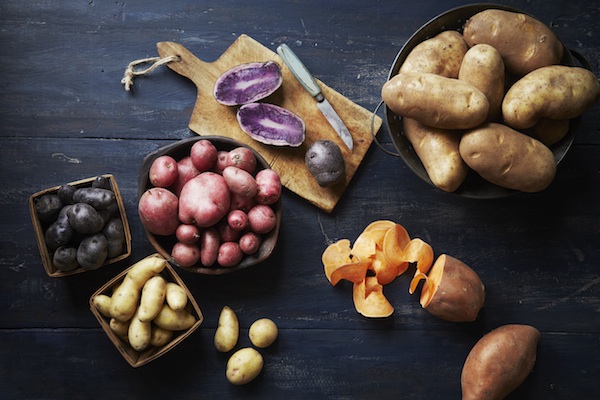
Of course, we usually don’t see that diversity in the average supermarket. Commercial breeding ensures that we buy only a few potato or sweet potato types.
For instance, fast-food restaurants demand a potato type (such as Russets) that has a particular size and shape, cuts well into French fries and holds together when deep-fried, but has a mealy, floury texture on the inside.
Indeed, most of the potatoes grown in North America are destined for the deep fryer.
Potato types
Potatoes can also differ in their starch content and type, which affects not only how fast they’re digested, but how they act when cooked.
Floury or “mealy” potatoes, which have a fluffy texture and are thus ideal for baking or mashing, are higher in starch, particularly amylose.
“Waxy” potatoes have less total starch but are higher in amylopectin, which helps the potato hold together and gives it a slightly “gluey” texture. This makes them better for boiling. They also digest more slowly, especially if they’re cooked and then cooled.
Similarly, sweet potato types can vary in their texture, cooking properties, moisture, and sugar levels: White, yellow and purple-fleshed sweet potatoes are typically the dry type, while the orange-fleshed are moist.
What about the “carb” question?
Tubers are enlarged roots or stems that plants use to store nutrients. This is what makes them a good source of energy — in this case, starchy carbohydrates.
Tubers have been a food source for humans for millennia.
But in recent years, eaters have gotten concerned about carbs. People wonder about whether they should eat potatoes at all… aren’t they too “high-carb”?
For one thing, “high-carb” often isn’t the real problem.
Most people in North America, Western Europe, and Australia consume potatoes in some processed form — as French fries, tater tots, or potato chips.
And in North America — especially in the Southern US — the phrase “sweet potato” is often followed by “pie”.
We typically slather spuds with other stuff, like butter or sour cream — and for our poutine-loving Canadian friends, gravy and cheese curds.
So the tubers themselves are not necessarily to blame. It’s all the stuff we serve them with.
Carbs and satiety
In fact, partially due to their carbohydrate content, potatoes and sweet potatoes are highly satiating foods.
You eat them, they “stick to your ribs”, and you feel full for a long time.
(There’s a reason that “meat and potatoes” is used to describe a satisfying meal.)
In fact, in 2010, Chris Voigt, the executive director of the Washington State Potato Commission, tried a crazy experiment: 2 months of eating only potatoes.
At first, he ate only when he felt hungry, and lost 12 lb in 3 weeks. To get enough calories, he then increased his intake to 20 potatoes a day… and he said he’d never felt so stuffed.
Despite apparently meeting his calorie needs, Voigt lost 9 more pounds throughout the rest of the experiment. Not only that, his blood measures (such as cholesterol, triglycerides, and blood glucose) improved.
Now of course, we don’t recommend the 20-potato-a-day diet. But Voigt’s results suggest — at least anecdotally — that in fact, starchy tubers are more satisfying and less fat-promoting than low-carb advocates might expect.
In part, this is because of the type of carbohydrate that occurs in potatoes and sweet potatoes.
Carbohydrate type: Starch or sugar?
Here’s how a medium baked potato a medium sweet potato compare in terms of calories, fiber, and macronutrient content.
| Potatoes | Sweet potatoes | |
|---|---|---|
| 1 medium sized, baked | 1 medium sized, baked | |
| Calories | 161 | 103 |
| Protein | 4.3 g | 2.3 g |
| Fat | 0 g | 0 g |
| Carbohydrates | 37 g | 24 g |
| Fiber | 3.8 g | 3.8 g |
Looks pretty similar. But let’s examine the carbohydrate type more closely.
| Potatoes | Sweet potatoes | |
|---|---|---|
| 1 medium sized, baked | 1 medium sized, baked | |
| Starch | 29.9 g | 8.0 g |
| Sugars | 2.0 g | 7.4 g |
|
Sucrose
|
692 mg | 2599 mg |
|
Glucose
|
761 mg | 650 mg |
|
Fructose
|
588 mg | 570 mg |
Note: Medium potato: 173 grams. Medium sweet potato: 114 grams. The table above compares medium-sized tubers, which reflect a typical portion (cupped handful). Source: Nutritiondata.self.com.
As you can see above, sweet potatoes are indeed sweeter: They have almost 4 times the sugar content of regular potatoes. (However, if regular potatoes are stored in cold storage, over time their starch content slowly transforms into glucose and fructose.)
Resistant starch
Most tubers contain some resistant starch — complex starch molecules that we can’t digest, which are then broken down by our gut bacteria in our large intestine.
Compared to sweet potatoes, regular potatoes have more resistant starch.
Potatoes also have a type of resistant starch known as retrograde starch: When you cook and then cool potatoes, the starch molecules shuffle themselves around into a different structure.
(You might have noticed the same type of phenomenon if you’ve ever cooked a batch of oatmeal, refrigerated it, and noticed a jelly-like texture after it was chilled.)
You can see the difference that temperature makes in the chart below. We’ve added some cooked lentils and bananas for comparison.
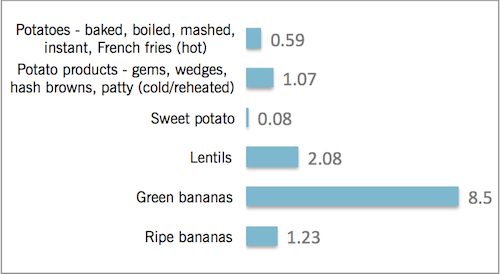
To digest both potatoes and sweet potatoes, we have to break down and release the starch stored inside their cells.
Because some of that starch is resistant starch, this breakdown takes time and effort, so although both potatoes and sweet potatoes are high in carbs, they don’t act the same way in our body as high-carb processed foods.
(For more on resistant starch, see All About Resistant Starch.)
Glycemic score
Along with being “high-carb”, eaters have often worried about the glycemic index (GI) and glycemic load (GL) of potatoes and sweet potatoes.
GI is a measure of how quickly a food converts to glucose.
GL is a measure of how much a food converts to glucose.
Thus, eaters are told to avoid foods with a high GI and/or GL. Many people thus choose sweet potatoes over regular potatoes, fearing that regular potatoes will shoot their blood sugar sky-high.
Here’s how the GI and GL of potatoes compares to sweet potatoes.
(We’ve also included lentils and bananas, just to give you an idea of how the tubers stack up to other common “high-carb” foods.)
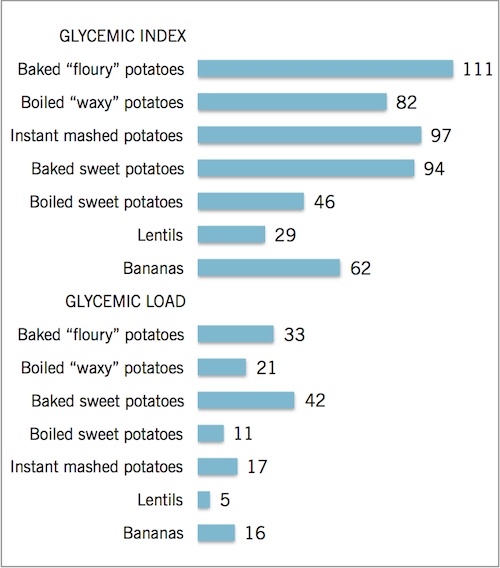
Interestingly, an extract (known as caiapo) from white sweet potatoes is a promising type 2 diabetes treatment, and has been shown to improve many markers of metabolic disease.
In fact, locals in Japan commonly ate white sweet potatoes raw as a treatment for anemia, hypertension, and diabetes.
Here’s a comparison of the blood glucose response to sweet potatoes, regular potatoes, regular potatoes with caiapo, and plain old glucose.
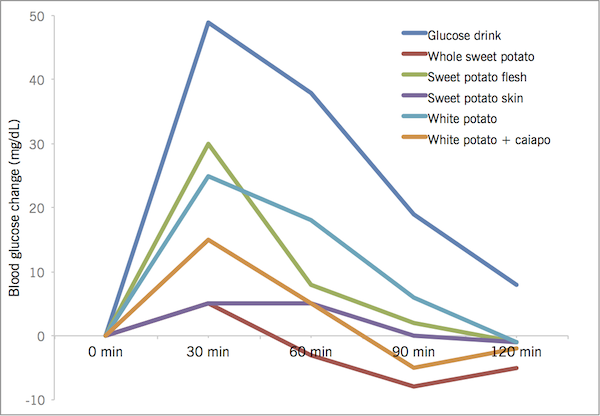
The problem with GI / GL
As you can see, white potatoes do often score higher on glycemic index and glycemic load tests than sweet potatoes. But does this mean we should treat regular potatoes like they’re dirt-covered sugar cubes? Absolutely not.
GI and GL are only a small part of the story.
GI changes with food type (say, floury vs. waxy potatoes).
GI changes when other foods are introduced. We don’t usually grab a plain baked potato and start gnawing on it. We generally eat both potatoes and sweet potatoes as part of meals.
GI changes with food preparation. Boiling usually results in a lower GI, since starch can bind with water. The dry heat of baking, on the other hand, lowers moisture and concentrates sugars. Cutting up potatoes and sweet potatoes helps preserve their starchiness, while cooking them whole results in more sugariness.
As you can see in the chart below, sweet potatoes do not automatically have a “better” GI than white potatoes. A roasted or baked sweet potato has a higher GI than a boiled white potato, for example.
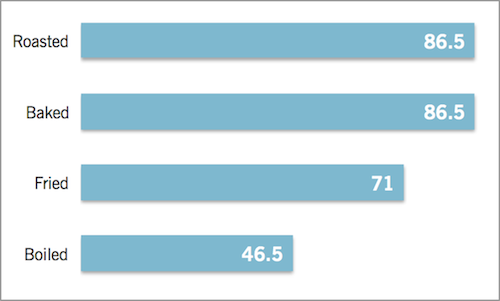
Source: Bahado-Singh, 2011.
In the end, if you’re following Precision Nutrition guidelines, you’re probably including lean proteins, healthy fats, other vegetables and fruits, and naturally occurring fiber in your diet.
You’re probably also active, which helps your body process carbohydrates better.
This means that GI / GL is not the only thing you should consider when judging the “healthiness” of a food.
And it also means that most healthy and active people can eat potatoes and sweet potatoes just fine.
Carb type matters
Thus, even though both potatoes and sweet potatoes are “high in carbs”, not all carbs are created equal.
Because of the type and nature of the carbohydrates they contain, both potatoes and sweet potatoes fill us up, give us energy, and leave us satiated for a long time.
As a bonus, sweet potatoes often satisfy sugar cravings, especially if they’re baked and caramelized.
Purple-skinned, white-fleshed sweet potatoes in particular (often found in East Asian cuisines) tend to have a “cakey”, caramel taste that makes them perfect for managing the occasional sugar jones.
Vitamins and minerals
In general, potatoes and sweet potatoes are roughly similar in their vitamin and mineral content.
But when it comes to vitamins and minerals, orange sweet potatoes are vitamin A superstars.
Vitamin A occurs in retinol form in animal foods such as eggs, and in rich industrialized countries, many people can afford to eat these foods. Many processed foods are also vitamin A fortified, so few of us in North America suffer vitamin A deficiency.
However, in poorer countries, vitamin A deficiency is a common problem, causing blindness, other health problems, and over 600,000 deaths per year (mostly of young children or pregnant women).
Along with other colorful fruits and vegetables (such as leafy greens and squash), orange sweet potatoes contain high levels of the carotenoid form of vitamin A. As little as a cupped handful of sweet potato a day can provide all the vitamin A that a small child needs.
Improving access to sweet potatoes and breeding vitamin A-rich sweet potatoes are thus important nutritional strategies for preventing vitamin A deficiency.
| Potato | Sweet potato | |
|---|---|---|
| 1 medium sized, baked | 1 medium sized, baked | |
| Vitamin A | 17.3 IU | 21907 IU |
| Thiamin (B1) | 0.1 mg | 0.1 mg |
| Riboflavin (B2) | 0.1 mg | 0.1 mg |
| Niacin (B3) | 2.4 mg | 1.7 mg |
| Pantothenic acid (B5) | 0.7 mg | 1.0 mg |
| Vitamin B6 | 0.5 mg | 0.3 mg |
| Folate (B9) | 48.4 mcg | 6.8 mcg |
| Vitamin B12 | 0 | 0 |
| Vitamin C | 16.6 mg | 22.3 mg |
| Vitamin D | 0 | 0 |
| Vitamin E | 0.1 mg | 0.8 mg |
| Vitamin K | 3.5 mcg | 2.6 mcg |
| Calcium | 25.9 mg | 43.3 mg |
| Copper | 0.2 mg | 0.2 mg |
| Iron | 1.9 mg | 0.8 mg |
| Magnesium | 48.4 mg | 30.8 mg |
| Manganese | 0.4 mg | 0.6 mg |
| Phosphorus | 121 mg | 61.6 mg |
| Potassium | 926 mg | 541 mg |
| Selenium | 0.7 mcg | 0.2 mcg |
| Sodium | 17.3 mg | 41.0 mg |
| Zinc | 0.6 mg | 0.4 mg |
Source: Nutritiondata.self.com
Antioxidants & phytonutrients
Both potatoes and sweet potatoes contain antioxidants, substances that help control oxidative damage in the body.
The phytochemicals (plant chemicals) in potatoes and sweet potatoes may also keep us healthy by regulating the immune system, fighting viruses and other pathogens, controlling inflammation, and inhibiting tumour growth.
Along with substances such as carotenoids (vitamin A precursors), ascorbic acid (vitamin C), and tocopherols (vitamin E), potatoes and sweet potatoes also contain a host of other potentially helpful phytochemicals, including:
|
|
As with other colorful fruits and veggies, colored potatoes and sweet potatoes (i.e. yellow, orange, and purple-fleshed varieties) are higher in these beneficial plant chemicals.
In fact, red-fleshed or purple-fleshed potatoes are comparable to Brussels sprouts, blueberries or spinach!
Feel-good chemicals
Fun factoid! Potatoes also contain trace amounts of naturally occurring temazepam and diazepam (aka Valium) along with L-tyrosine (a precursor to dopamine, one of our “feel-good” neurotransmitters).
Both potatoes and sweet potatoes also contain roughly the same amounts of L-tryptophan, the raw materials for serotonin, another “feel-good” neurotransmitter that makes us feel calm and happy.
No wonder you feel so groovy after those spuds.
Antinutrients
Antinutrients are substances that either interfere with nutrient absorption, or act as toxins in the body.
Almost all plant foods contain antinutrients as natural defenses against pests, diseases, and environmental threats. Tubers are no exception.
For instance, most tubers are relatively toxic when uncooked. And, as mentioned, green potatoes are poisonous (so cut off the green bits or toss green potatoes altogether).
In the end, both potatoes and sweet potatoes — like nearly all other plant foods — have some antinutrients.
Luckily, these occur in very low levels, and most of the time our bodies are perfectly able to process them.
Potato antinutrients
Potatoes contain proteins such as patatins and lectins which can be allergenic, particularly if potatoes are eaten raw.
People who have other allergies (particularly latex allergies) are more susceptible to potato allergies, as are children. Lectins can cause intestinal damage.
Potatoes also contain protease inhibitors, which may prompt an allergic reaction or interfere with the digestion of proteins.
Potatoes contain salicylates, which can cause problems for those with a salicylate intolerance.
Finally, the Solanaceae family of plants (which, again, contains tomatoes, peppers, and eggplant) may be somewhat inflammatory, and can produce reactions in susceptible people.
However, most of these are problems only for people with existing allergies, intolerances, and autoimmune disorders. If you eat potatoes and feel fine, don’t worry about it.
Sweet potato antinutrients
About 80 percent of the protein in sweet potatoes is sporamin, which is a trypsin inhibitor. Trypsin inhibitors can interfere with digestion by reducing the action of the digestive enzyme trypsin (which helps us digest proteins).
However, sporamin may also be an antioxidant.
As with potatoes, cooking decreases or removes many sweet potato antinutrients. Sweet potato allergy or intolerance is quite rare.
What makes a food “healthy”?
As you can guess by now, several factors determine whether potatoes and sweet potatoes (or, for that matter, most other foods) are more or less “healthy” or appropriate for your goals.
How they’re prepared
Eat potatoes and sweet potatoes cooked rather than raw.
Baking, boiling, or roasting potatoes and sweet potatoes is generally healthier than frying them. When fried, the starch can create harmful acrylamides.
What you eat them with
Check your sweet potatoes. Is there a pie crust underneath them or marshmallows on top of them?
Can you even see that baked potato underneath the mound of sour cream and cheese?
Hmm… then maybe not ideal for a daily dish.
But if you see broccoli and perhaps a nice grass-fed steak, or wild-caught salmon, or some beans with those tubers… go for it!
A little bit of healthy fat with sweet potatoes in particular will help you absorb their vitamin A.
Processed vs unprocessed
When eaten as whole, minimally processed plant foods, both potatoes’ and sweet potatoes’ carbohydrates are relatively slow-burning.
So opt for the Niçoise salad over the instant mashed potato flakes, potato vodka, and sweet potato syrup.
Nutrient density
When eaten as whole, minimally processed foods, both potatoes and sweet potatoes are nutrient-dense.
(Sure, they’re not kale, but then again, few foods are.)
Both potatoes and sweet potatoes contain vitamins and minerals, antioxidants and phytonutrients.
If you’re looking for a blast of carotenoid vitamin A, an orange-fleshed sweet potato is a clear winner. However, if you fancy a little anthocyanin antioxidant action, try a blue-fleshed potato. Mix it up!
Satiety
Less-healthy foods are often easier to overeat. They leave you unsatisfied, craving more.
Sure, we’ve all indulged in a mashed potato fest at Thanksgiving or sweet potato fries at our local pub. But when we prepare both potatoes and sweet potatoes properly and eat them slowly as part of a normal, PN-friendly diet, we’ll usually find both to be satisfying and filling.
Effects on the food chain and environment
Potatoes and sweet potatoes are relatively hardy crops that are easy to grow in most climates, although sweet potatoes prefer things a little warmer. Even if you only have a little space, you can grow both types of tubers in a bucket.
Comparatively, potatoes and sweet potatoes are low-impact crops, requiring minimal water or additional processing.
Your heritage and history
Part of “health” is being able to enjoy food with others, and connect to our heritage. Potatoes and sweet potatoes are part of most traditional cuisines.
Thus, aside from their nutrient content, potatoes and sweet potatoes promote “health” through food and social relationships.
Summary: What we recommend
“Lab significant” vs “real-world significant”
You might have guessed that while we rely a lot on clinical research, we also try to keep a sense of perspective.
We try not to get bogged down in the numbers, or look at single nutrients or foods in isolation.
After all, people don’t eat “nutrients”. They eat food. They eat meals.
Having a baked potato with a meal or enjoying Grandma’s potato salad at a family reunion along with 7 other dishes is a lot different from being a fasted test subject who is fed exactly 200 grams of baked potato and nothing else.
“Lab significant” — i.e. small variations in numbers — is not “real-world significant” — i.e. what matters to real, unique people living real lives in real bodies.
So we work closely with Precision Nutrition Coaching clients to see how scientific theories and findings manifest in real life — outside of the lab.
PN’s eating guidelines
Based on the available research and our experience helping over 150,000 clients improve their eating habits:
We recommend both potatoes and sweet potatoes as part of a health-promoting diet, because we know that including both:
- gives people “carb variety”;
- helps people feel psychologically satisfied and physically satiated;
- helps give people steady, slow-burn energy; and
- helps people feel “normal” when changing their dietary habits (because potatoes and sweet potatoes are familiar foods).
Moreover, people can easily adapt this general recommendation to meet their individual goals.
We recommend starting with a baseline of 1 to 2 cupped handfuls of starchy carbs per meal. This can be potatoes or sweet potatoes, but also a host of other delicious and nutritious choices: beans and lentils, fruit, whole minimally processed grains, etc.
We recommend that people adjust their portion sizing and food choices based on:
- their individual goals (fat loss, mass gain, fuel for athletic performance, etc.);
- their individual body size (smaller people get less; larger people get more);
- their individual carb needs (which, if you’re active and leaner, will usually be higher);
- their individual food sensitivities; and
- their individual preferences.
We recommend that people experiment with various types of potatoes and sweet potatoes as well as cooking methods and cuisines. Variety is the spice of life!
For more on potatoes, check out All About Potatoes.
What to do next:
Some tips from Precision Nutrition.
Get beyond “good foods” and “bad foods”.
Instead, ask: Does this food add value to my body? Does it nourish me and benefit me? Both potatoes and sweet potatoes can be a valuable part of your healthy diet.
Try something new.
Explore the types of potatoes and sweet potatoes available. Look for unusual or colorful varieties at your local farmers’ market. Or grow some in your own garden.
Choose whole, fresh, minimally processed foods.
Whether it’s a regular potato or a sweet potato, it’s still better than potato chips.
Give thought to preparation.
Bake, boil, roast, and/or steam your potatoes and sweet potatoes. Cook potatoes instead of eating them raw. If you want to take advantage of the retrograde starch, cool your potatoes after cooking.
Observe how YOU feel after eating a given food.
Do you feel invigorated or immobilized after a potato or sweet potato? Satisfied or starving? Full of long-lasting energy or napping in the corner? Lean and light or heavy and sluggish? Gather data and act accordingly.
Watch for signals of sensitivities and intolerances.
If you suspect you may have a food intolerance, try keeping a food journal to see if you can associate your symptoms with a particular food. White potatoes may be a problem, if you have an underlying susceptibility (such as an autoimmune disease or other allergies, particularly a latex allergy). Most common potato intolerance symptoms reported are eczema, stomach upset, hives and swelling, or — in rare situations — anaphylaxis. For most people (especially adults), potatoes are perfectly fine.
References
Click here to view the information sources referenced in this article.
If you’re a coach, or you want to be…
You can help people build sustainable nutrition and lifestyle habits that will significantly improve their physical and mental health—while you make a great living doing what you love. We'll show you how.
If you’d like to learn more, consider the PN Level 1 Nutrition Coaching Certification. (You can enroll now at a big discount.)

Share